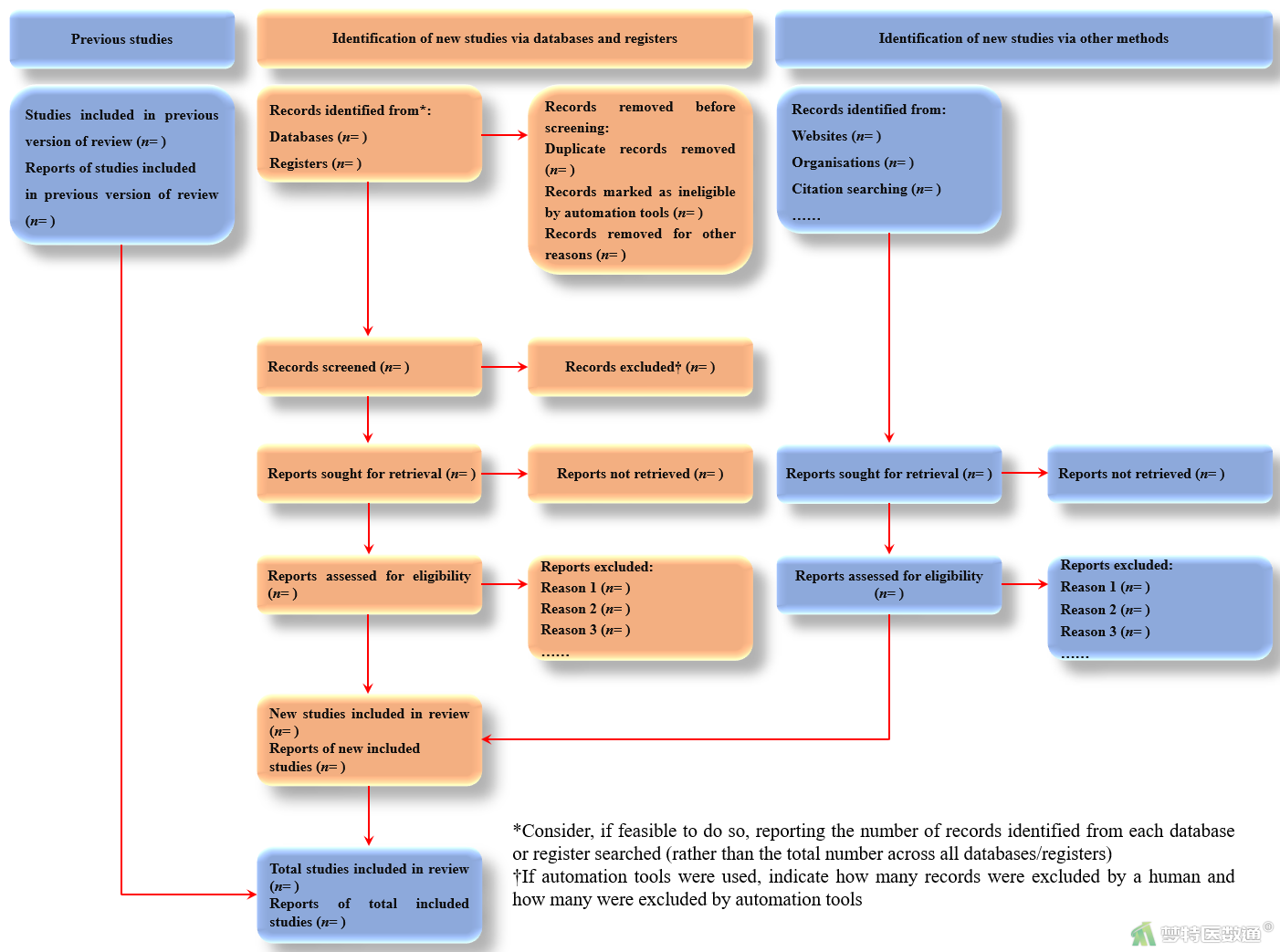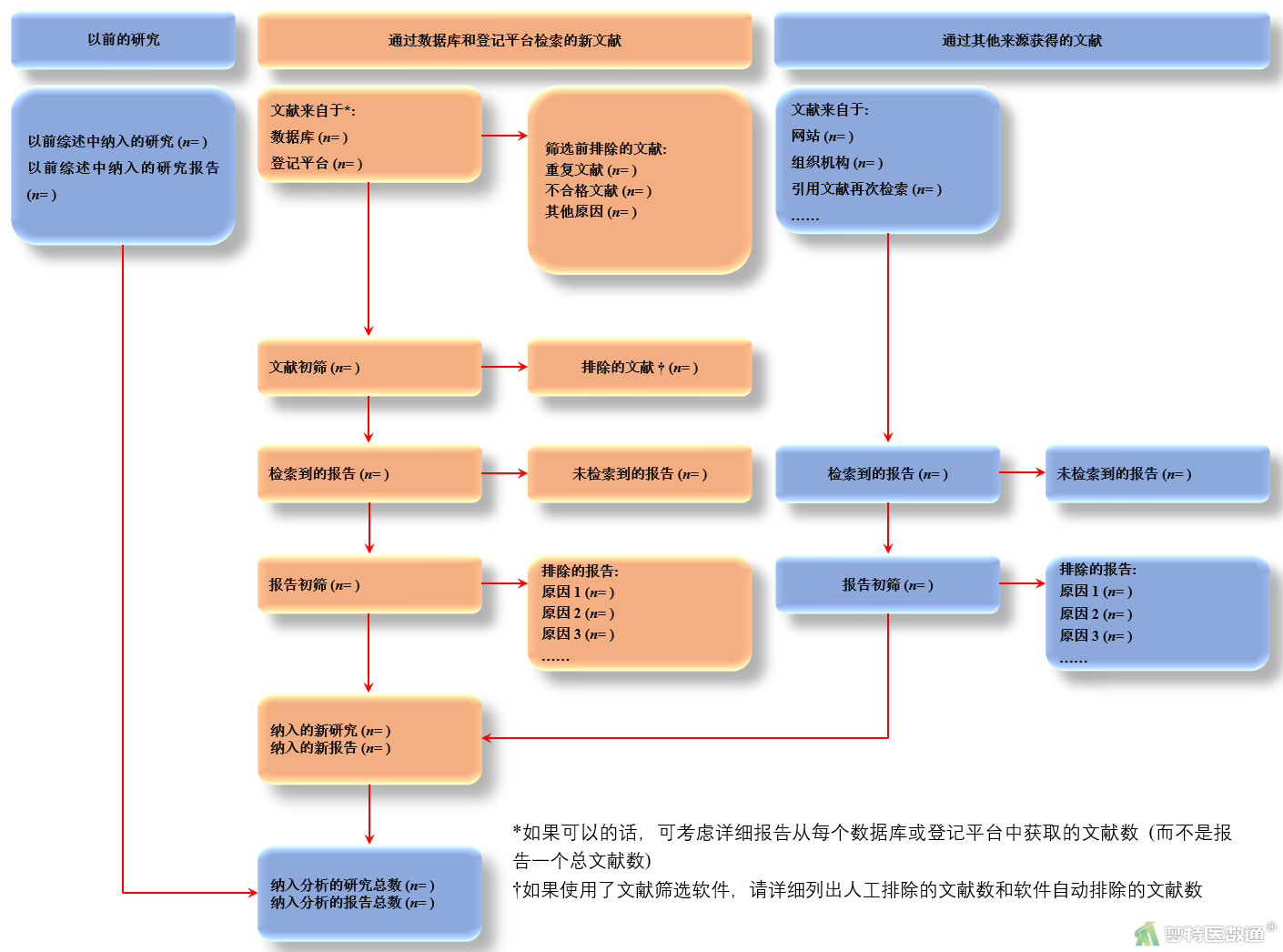系统综述的质量很大程度上取决于对研究问题、方法及结果的报告是否明晰。低质量的报告很可能会影响读者对文章结果的评价,进而影响其实际的应用价值。系统综述和Meta分析优先报告条目(Preferred Reporting Items for Systematic Reviews and Meta-Analyses, PRISMA)是用于指导随机对照试验和其他类型研究设计的系统评价和Meta分析的指南。本文主要概述PRISMA 2020声明的背景、条目清单和使用注意事项。
关键词:系统综述;Meta分析;系统综述和Meta分析优先报告条目;系统综述报告规范;Meta分析报告规范;PRISMA声明
一、PRISMA 2020声明背景
系统综述是指针对某种疾病或某一治疗措施收集所有相关的临床研究,并采用循证医学与临床流行病学严格评价文献的原则和方法,必要时进行量化的统计学处理,再得出综合结论的过程,也称系统评价。Meta分析是一种常见的定量系统评价方法。系统综述的质量很大程度上取决于对研究问题、方法以及结果的报告是否明晰。低质量的报告很可能会影响读者对文章结果的评价,进而影响其实际的应用价值。
为了提高系统综述和Meta分析报告质量,1999年,加拿大渥太华大学成立了由David Moher领导的QUOROM (Quality of Reporting of Meta-analyses)专家小组提出了一套针对随机对照试验(Random Control Test, RCT) Meta分析的统一报告格式,即QUOROM规范。2005年6月,在加拿大渥太华,专家小组修订并扩展了QUOROM规范,将其更名为系统综述和Meta分析优先报告条目(Preferred Reporting Items for Systematic Reviews and Meta-Analyses,PRISMA)。2009年PRISMA声明首次发布。为了适应新需求,Page等对PRIMSA 2009声明进行了更新和修订,形成了PRISMA 2020声明并于2021年3月在线发表。PRISMA 2020 声明分为标题、摘要、前言、方法、结果、讨论和其他信息 7 个部分,共包含 27个条目 (42个次级条目)。
二、PRISMA 2020声明扩展板
QUOROM规范适用范围较窄,仅限于RCT的Meta分析;而PRISMA声明覆盖了系统综述的整个过程,可以探讨更大范围的研究问题,如研究成本―效果、诊断方法、预后、遗传相关性研究以及政策制定研究的系统综述。然而一些特殊情况下,仍需对一些条目和图表进一步完善,以便在不同领域更好地应用。
PRISMA扩展版主要包括以下版本:
- 摘要的系统综述和Meta分析优先报告条目 (PRISMA for Abstracts)
- 针灸试验的系统综述和Meta分析优先报告条目 PRISMA-A (PRISMA for Acupuncture)
- 中草药的系统综述和Meta分析优先报告条目 (PRISMA for Chinese Herbal Medicine)
- 复杂干预的系统综述和Meta分析优先报告条目 (PRISMA for Complex Interventions)
- 结果测量工具的系统综述和Meta分析优先报告条目—基于共识的选择健康测量工具的标准 (PRISMA-COSMIN for Outcome Measurement Instruments)
- 诊断准确性试验的系统综述和Meta分析优先报告条目 PRISMA-DTA (PRISMA for Diagnostic Test Accuracy)
- 生态学与进化生物学试验系统综述和Meta分析优先报告条目 (PRISMA for EcoEvo)
- 卫生公平性研究系统综述和Meta分析优先报告条目 (PRISMA Equity)
- 用于包括伤害结果的系统综述和Meta分析优先报告条目 (PRISMA Harms for reviews including Harm outcomes)
- 个体资料的系统综述和Meta分析优先报告条目 PRISMA-IPD (PRISMA for Individual Patient Data)
- 艾灸系统综述和Meta分析优先报告条目 (PRISMA Moxibustion)
- 网状系统综述和Meta分析优先报告条目PRISMA-NMA (PRISMA for Network Meta-Analyses)
- 研究方案的系统综述和Meta分析优先报告条目 PRISMA-P (PRISMA for Protocols)
- 范围系统综述和Meta分析优先报告条目 PRISMA-ScR (PRISMA for Scoping Reviews)
- 系统综述和Meta分析优先报告条目检索 (PRISMA Search)
本文着重介绍PRISMA 2020报告规范的清单条目,如需了解更多关于PRISMA声明的信息,建议访问其官方网站(http://prisma-statement.org/)。
三、PRISMA 2020条目清单及流程图
(一) PRISMA 2020条目清单
表1 PRISMA2020条目清单的中英文对照
| Section and topic 章节和主题 | Item 条目序号 | Checklist item 条目内容 |
| Title 标题 | ||
| Title 标题 | 1 | Identify the report as a systematic review. 明确报告该研究为系统综述 |
| Abstract 摘要 | ||
| Abstract 摘要 | 2 | See the PRISMA 2020 for Abstracts checklist (table 2). 详见PRISMA 2020摘要清单(表2) |
| Introduction 引言 | ||
| Rationale 理由 | 3 | Describe the rationale for the review in the context of existing knowledge. 阐述在现有知识背景下开展该综述的理由 |
| Objectives 目的 | 4 | Provide an explicit statement of the objective(s) or question(s) the review addresses. 对综述所解决的目的或问题进行清晰阐述 |
| Methods 方法 | ||
| Eligibility criteria 纳入与排除标准 | 5 | Specify the inclusion and exclusion criteria for the review and how studies were grouped for the syntheses. 明确综述的纳入和排除标准及如何将研究分组以进行合成 |
| Information sources 信息来源 | 6 | Specify all databases, registers, websites, organizations, reference lists and other sources searched or consulted to identify studies. Specify the date when each source was last searched or consulted. 明确所有检索或查询的数据库、注册平台、网站、组织机构、参考文献清单或其他资源,以及每个资料来源的最后检索日期 |
| Search strategy 检索策略 | 7 | Present the full search strategies for all databases, registers and websites, including any filters and limits used. 呈现所有数据库、注册平台和网站的全部检索策略,包括所使用的筛选和限定条件 |
| Selection process 文献选择 | 8 | Specify the methods used to decide whether a study met the inclusion criteria of the review, including how many reviewers screened each record and each report retrieved, whether they worked independently, and if applicable, details of automation tools used in the process. 详细说明决定研究是否符合综述纳入标准的方法,包括筛选的研究人员数量,他们的工作是否独立。如果适用,还应详细说明该过程中使用的自动化工具 |
| Data collection process 数据提取 | 9 | Specify the methods used to collect data from reports, including how many reviewers collected data from each report, whether they worked independently, any processes for obtaining or confirming data from study investigators, and if applicable, details of automation tools used in the process. 明确数据提取所使用的方法,包括提取数据的研究人员数量,他们是否独立工作,任何向原文作者获取或确认资料的过程。如果适用,还应详细说明该过程中使用的自动化工具 |
| Data items 资料条目 | 10a | List and define all outcomes for which data were sought. Specify whether all results that were compatible with each outcome domain in each study were sought (e.g. for all measures, time points, analyses), and if not, the methods used to decide which results to collect. 列出并定义所有需要获取数据的结局指标。明确是否提取每个研究中与设定结局相符的所有信息(如测量方法、时间点、分析方法)。若不是,则应描述收集特定结果的方法 |
| 10b | List and define all other variables for which data were sought (e.g. participant and intervention characteristics, funding sources). Describe any assumptions made about any missing or unclear information. 列出并定义需要获取数据的所有其他变量(如参与者和干预特征、资金来源)。描述针对缺失数据或不明信息做出的任何假设 | |
| Study risk of bias assessment 研究存在的偏倚风险评估 | 11 | Specify the methods used to assess risk of bias in the included studies, including details of the tool(s) used, how many reviewers assessed each study and whether they worked independently, and if applicable, details of automation tools used in the process. 明确描述用于评价纳入研究偏倚风险的方法,包括使用的评价工具,评价人员数量及评价人员是否独立评价。如果适用,应详细说明该过程中使用的自动化工具的详细信息 |
| Effect measures 效应指标 | 12 | Specify for each outcome the effect measure(s) (e.g. risk ratio, mean difference) used in the synthesis or presentation of results. 说明每个结局指标合成或结果呈现时使用的效应指标(如风险比,平均差异) |
| Synthesis methods 合成方法 | 13a | Describe the processes used to decide which studies were eligible for each synthesis (e.g. tabulating the study intervention characteristics and comparing against the planned groups for each synthesis (item #5)). 描述每个指标合成中纳入研究的过程[如将研究文献特征制成表格并与每个计划的合成组进行比较(条目5)] |
| 13b | Describe any methods required to prepare the data for presentation or synthesis, such as handling of missing summary statistics, or data conversions. 描述任何准备数据展示或合并的方法,如缺失数据的处理、数据转换方式 | |
| 13c | Describe any methods used to tabulate or visually display results of individual studies and syntheses. 描述用于展示单个研究结果和综合结果的表或图的方法 | |
| 13d | Describe any methods used to synthesise results and provide a rationale for the choice(s). If meta-analysis was performed, describe the model(s), method(s) to identify the presence and extent of statistical heterogeneity, and software package(s) used. 描述用于结果合成的方法并说明选择相应方法的理由。如果进行了Meta分析,应描述用于探索统计学异质性的模型、方法及软件包 | |
| 13e | Describe any methods used to explore possible causes of heterogeneity among study results (e.g. subgroup analysis, meta regression). 描述用于探索研究结果异质性原因的任何方法(如亚组分析、Meta回归分析) | |
| 13f | Describe any sensitivity analyses conducted to assess robustness of the synthesised results. 描述评价合成结果稳定性所开展的任何敏感性分析 | |
| Reporting bias assessment 报告偏倚评估 | 14 | Describe any methods used to assess risk of bias due to missing results in a synthesis (arising from reporting biases). 描述合成中评估结果缺失所致偏倚风险的任何方法方法(源于报告偏倚) |
| Certainty assessment 确定性评估 | 15 | Describe any methods used to assess certainty (or confidence) in the body of evidence for an outcome. 描述用于评价结果证据确定性(或置信度)的任何方法 |
| Results 结果 | ||
| Study selection 研究文献选择 | 16a | Describe the results of the search and selection process, from the number of records identified in the search to the number of studies included in the review, ideally using a flow diagram (see fig 1). 描述检索和筛选文献的过程及结果,从最初检索获取的文献数量到最终纳入研究的数量,最好提供流程图(见图1) |
| 16b | Cite studies that might appear to meet the inclusion criteria, but which were excluded, and explain why they were excluded. 列出符合纳入标准但被排除的研究,并说明排除原因 | |
| Study characteristics 研究特征 | 17 | Cite each included study and present its characteristics. 列出每个纳入的研究并呈现其特征 |
| Risk of bias in studies 研究偏倚风险 | 18 | Present assessments of risk of bias for each included study. 呈现每个纳入研究的偏倚风险评估结果 |
| Results of individual studies 单个研究结果 | 19 | For all outcomes, present, for each study: (a) summary statistics for each group (where appropriate) and (b) an effect estimate and its precision (e.g. confidence/credible interval), ideally using structured tables or plots. 针对所有结局指标,说明每个研究:(a)每组的统计学描述(如果可行)和(b)效应量及精度(如置信/可信区间),最好使用结构式表格或图形 |
| Results of syntheses 结果的合并 | 20a | For each synthesis, briefly summarise the characteristics and risk of bias among contributing studies. 对于每个合并的结果,简要总结纳入研究的特征及偏倚风险 |
| 20b | Present results of all statistical syntheses conducted. If meta-analysis was done, present for each the summary estimate and its precision (e.g. confidence/credible interval) and measures of statistical heterogeneity. If comparing groups, describe the direction of the effect. 呈现所有统计学合并的结果。如果开展了Meta分析,呈现每个Meta分析的估计值、精确度(如置信/可信区间)及异质性检验结果。如果进行了组间比较,需描述效应方向 | |
| 20c | Present results of all investigations of possible causes of heterogeneity among study results. 提供研究结果中可能导致异质性来源的调查结果 | |
| 20d | Present results of all sensitivity analyses conducted to assess the robustness of the synthesised results. 呈现敏感性分析的结果,以便评价合并结果的稳定性 | |
| Reporting biases 报告偏倚 | 21 | Present assessments of risk of bias due to missing results (arising from reporting biases) for each synthesis assessed. 呈现每个合并结果中因缺失所致偏倚风险的评估情况(报告偏倚) |
| Certainty of evidence 确定性评估 | 22 | Present assessments of certainty (or confidence) in the body of evidence for each outcome assessed. 针对每个结局,呈现证据确定性(或置信度)评价的结果 |
| Discussion 讨论 | ||
| Discussion 讨论 | 23a | Provide a general interpretation of the results in the context of other evidence. 在其他证据背景下对结果进行简要解释 |
| 23b | Discuss any limitations of the evidence included in the review. 讨论综述中纳入的证据的局限性 | |
| 23c | Discuss any limitations of the review processes used. 讨论系统评价过程中的局限性 | |
| 23d | Discuss implications of the results for practice, policy, and future research. 讨论研究结果对实践、政策以及未来研究的意义 | |
| Other information 其他信息 | ||
| Registration andProtocol 注册和方案 | 24a | Provide registration information for the review, including register name and registration number, or state that the review was not registered. 提供系统综述的注册信息,包括注册名称、注册编号,或声明综述未注册 |
| 24b | Indicate where the review protocol can be accessed, or state that a protocol was not prepared. 提供综述研究方案的获取途径,或声明未准备方案 | |
| 24c | Describe and explain any amendments to information provided at registration or in the protocol. 描述并解释对注册内容或研究方案的任何修改 | |
| Support 资金支持 | 25 | Describe sources of financial or non-financial support for the review, and the role of the funders or sponsors in the review. 描述综述的资金来源及资金支持者在研究过程中所起的作用,或声明无资金支持 |
| Competing interests 利益冲突 | 26 | Declare any competing interests of review authors. 声明综述作者的利益冲突 |
| Availability of data, code, and other Materials 数据、代码和其他材料的可用性 | 27 | Report which of the following are publicly available and where they can be found: template data collection forms; data extracted from included studies; data used for all analyses; analytic code; any other materials used in the review. 报告以下哪些信息是公开的,并提供获取途径:数据提取表模板、纳入研究的数据、用于分析的数据、数据分析代码、系统评价中使用的其他资料 |
(二) PRISMA 2020摘要条目清单
表2 PRISMA 2020摘要条目清单
| Section and topic 内容 | Item 条目序号 | Checklist item 条目内容 |
| Title 标题 | ||
| Title 标题 | 1 | Identify the report as a systematic review. 明确该报告为系统综述 |
| Background 背景 | ||
| Objectives 目的 | 2 | Provide an explicit statement of the main objective(s) or question(s) the review addresses. 清晰描述该综述的主要目的或要解决的问题 |
| Methods 方法 | ||
| Eligibility criteria 纳排标准 | 3 | Specify the inclusion and exclusion criteria for the review. 描述该综述的纳入与排除标准 |
| Information sources 信息来源 | 4 | Specify the information sources (e.g. databases, registers) used to identify studies and the date when each was last searched. 描述文献的信息来源(如数据库,注册平台)及每个来源的最后检索日期 |
| Risk of bias 偏倚风险 | 5 | Specify the methods used to assess risk of bias in the included studies. 描述用于评价纳入研究的偏倚风险的方法 |
| Synthesis of results 结果合并 | 6 | Specify the methods used to present and synthesise results. 描述用来呈现和综合结果的方法 |
| Results 结果 | ||
| Included studies 纳入研究 | 7 | Give the total number of included studies and participants and summarise relevant characteristics of studies. 呈现纳入研究和研究对象的数量,以及每个研究的相关特征 |
| Synthesis of results 结果合并 | 8 | Present results for main outcomes, preferably indicating the number of included studies and participants for each. If meta-analysis was done, report the summary estimate and confidence/credible interval. If comparing groups, indicate the direction of the effect (i.e. which group is favoured). 报告主要结果,最好呈现每个结果中的研究数量和研究对象数量。如果进行了Meta 分析,报告合并效应量及置信/可信区间。如果进行了组间比较,需描述效应方向(比如结果更支持哪个组) |
| Discussion 讨论 | ||
| Limitations of evidence 证据局限性 | 9 | Provide a brief summary of the limitations of the evidence included in the review (e.g. study risk of bias, inconsistency and imprecision). 简要总结纳入证据的局限性(如研究的偏倚风险、不一致性和不精确性) |
| Interpretation 解释 | 10 | Provide a general interpretation of the results and important implications. 对评价结果和主要意义作简要阐释 |
| Other 其他 | ||
| Funding 资金 | 11 | Specify the primary source of funding for the review. 说明该综述的主要资金来源 |
| Registration 注册 | 12 | Provide the register name and registration number. 提供注册名称及注册号 |
(三) PRISMA 2020声明流程图

图1 PRISMA 2020声明流程图(英文)

图1 PRISMA 2020声明流程图(中文)
四、PRISMA 2020声明使用注意事项
PRISMA 2020声明是指导作者报告评估医疗保健干预(如药物、设备、手术或心理干预)的RCT及其他类型研究设计的系统评价和Meta分析的指南。同行评议专家和编辑可参考PRISMA 2020声明来评审系统评价和Meta分析论文,能方便专家对作者完成系统评价和(或)Meta分析所采用的所有步骤进行全面审查,编辑可要求作者填写PRISMA 2020清单并将清单作为投稿的一部分提交,以此衡量作者提供的系统评价信息的详细程度,判断其结果的有效性,从而决定稿件是否录用。编辑也可将PRISMA 2020清单作为指导文件的一部分来完成同行评议,以确保编辑、同行评议专家、作者使用相同的清单,有助于提高系统评价报告撰写的清晰度、准确性和透明度。读者也可参考PRISMA 2020声明来评价系统评价和Meta分析结果的有效性。
系统评价是一个复杂的过程,作者未必能够记得他们完成这一过程所采取的每个步骤。通过使用PRISMA 2020清单和流程图可以提醒作者说明是否已经完成了这些步骤,如果已完成,是如何完成的。在报告系统评价和(或)Meta分析时,不一定要遵循PRISMA 2020清单条目的顺序和格式。同样,不一定所有PRISMA 2020清单条目都要完成。在系统评价过程中,作者可以选择不完成PRISMA 2020清单中的某些部分。PRISMA 2020声明的制定并不是对作者做了什么或没有做什么作出判断,而是为了帮助作者更加准确透明地说明完成系统评价和(或)Meta分析的过程。
虽然PRISMA 2020清单有助于编辑和同行评议员的评审工作,但其并不是评估系统评价或Meta分析质量的工具,用它来构建质量分数也不合适。PRISMA 2020声明的使用范围有限,主要是为了使系统评价和Meta分析更详细全面地进行报告而制定的。对于其他一些特殊类型的系统评价报告,则需参考相应的扩展版内容。
注:本文内容是参考相关文献后对PRISMA报告规范原文的概述,仅代表本网站观点。关于PRISMA声明的更多内容详见官方网站(http://prisma-statement.org/)或Matthew J Page等发表的论文“The PRISMA 2020 statement: an updated guideline for reporting systematic reviews ”、Matthew J Page等发表的论文“PRISMA 2020 explanation and elaboration: updated guidance and exemplars for reporting systematic reviews ”、高亚等发表的论文“系统评价报告规范:PRISMA 2020与PRISMA 2009的对比分析与实例解读”。